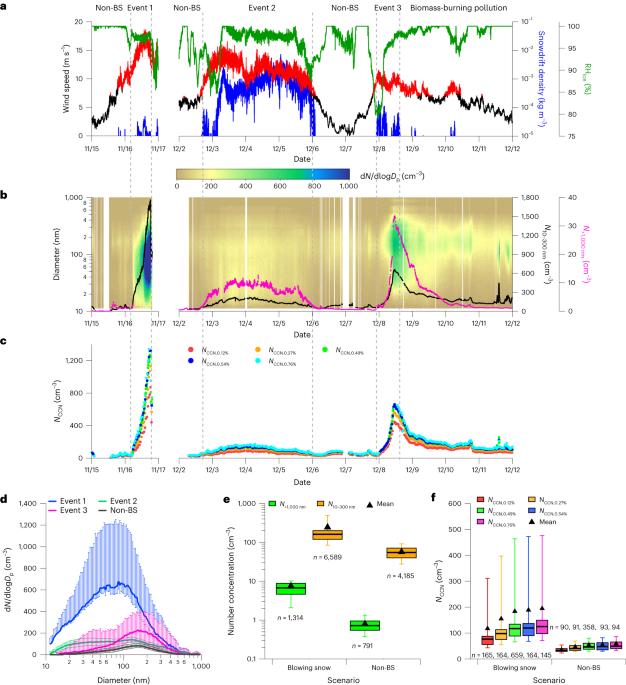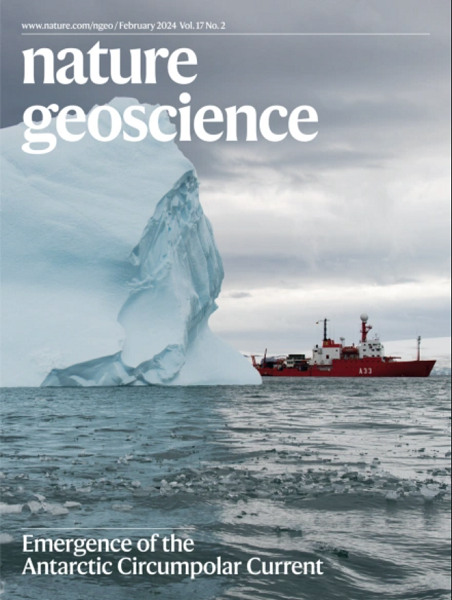吹雪产生的大量细海盐气溶胶导致北极变暖
IF 15.7
1区 地球科学
Q1 GEOSCIENCES, MULTIDISCIPLINARY
引用次数: 2
摘要
北极变暖的速度几乎是全球平均速度的四倍,气溶胶在北极气候变化中扮演着越来越重要的角色。在北极地区,就质量浓度而言,海盐是冬季和春季气溶胶的主要成分。然而,海盐气溶胶产生的机制仍不清楚。人们通常认为海盐气溶胶的体积相对较大,但数量浓度较低,这意味着它们对云凝结核数量和云特性的影响一般较小。在这里,我们提出了北极中部吹雪产生大量海盐气溶胶的观测证据。从 11 月到次年 4 月,20% 以上的时间都能观测到吹雪。吹雪的升华产生了高浓度的细模式海盐气溶胶(直径小于 300 纳米),使云凝结核浓度比背景水平高出 10 倍。利用全球化学传输模式,我们估计从 11 月到次年 4 月,在北纬 70 度以北,吹雪产生的海盐气溶胶约占总粒子数的 27.6%,海盐气溶胶增加了云的长波发射率,导致云天条件下的地表升温 +2.30 W m-2。根据 MOSAiC 考察队的观测结果,北极地区吹雪产生的细海盐气溶胶会影响云的特性并使地表变暖。本文章由计算机程序翻译,如有差异,请以英文原文为准。

Arctic warming by abundant fine sea salt aerosols from blowing snow
The Arctic warms nearly four times faster than the global average, and aerosols play an increasingly important role in Arctic climate change. In the Arctic, sea salt is a major aerosol component in terms of mass concentration during winter and spring. However, the mechanisms of sea salt aerosol production remain unclear. Sea salt aerosols are typically thought to be relatively large in size but low in number concentration, implying that their influence on cloud condensation nuclei population and cloud properties is generally minor. Here we present observational evidence of abundant sea salt aerosol production from blowing snow in the central Arctic. Blowing snow was observed more than 20% of the time from November to April. The sublimation of blowing snow generates high concentrations of fine-mode sea salt aerosol (diameter below 300 nm), enhancing cloud condensation nuclei concentrations up to tenfold above background levels. Using a global chemical transport model, we estimate that from November to April north of 70° N, sea salt aerosol produced from blowing snow accounts for about 27.6% of the total particle number, and the sea salt aerosol increases the longwave emissivity of clouds, leading to a calculated surface warming of +2.30 W m−2 under cloudy sky conditions. Fine sea salt aerosols produced by blowing snow in the Arctic impact cloud properties and warm the surface, according to observations from the MOSAiC expedition.
求助全文
通过发布文献求助,成功后即可免费获取论文全文。
去求助
来源期刊

Nature Geoscience
地学-地球科学综合
CiteScore
26.70
自引率
1.60%
发文量
187
审稿时长
3.3 months
期刊介绍:
Nature Geoscience is a monthly interdisciplinary journal that gathers top-tier research spanning Earth Sciences and related fields.
The journal covers all geoscience disciplines, including fieldwork, modeling, and theoretical studies.
Topics include atmospheric science, biogeochemistry, climate science, geobiology, geochemistry, geoinformatics, remote sensing, geology, geomagnetism, paleomagnetism, geomorphology, geophysics, glaciology, hydrology, limnology, mineralogy, oceanography, paleontology, paleoclimatology, paleoceanography, petrology, planetary science, seismology, space physics, tectonics, and volcanology.
Nature Geoscience upholds its commitment to publishing significant, high-quality Earth Sciences research through fair, rapid, and rigorous peer review, overseen by a team of full-time professional editors.
 求助内容:
求助内容: 应助结果提醒方式:
应助结果提醒方式:


